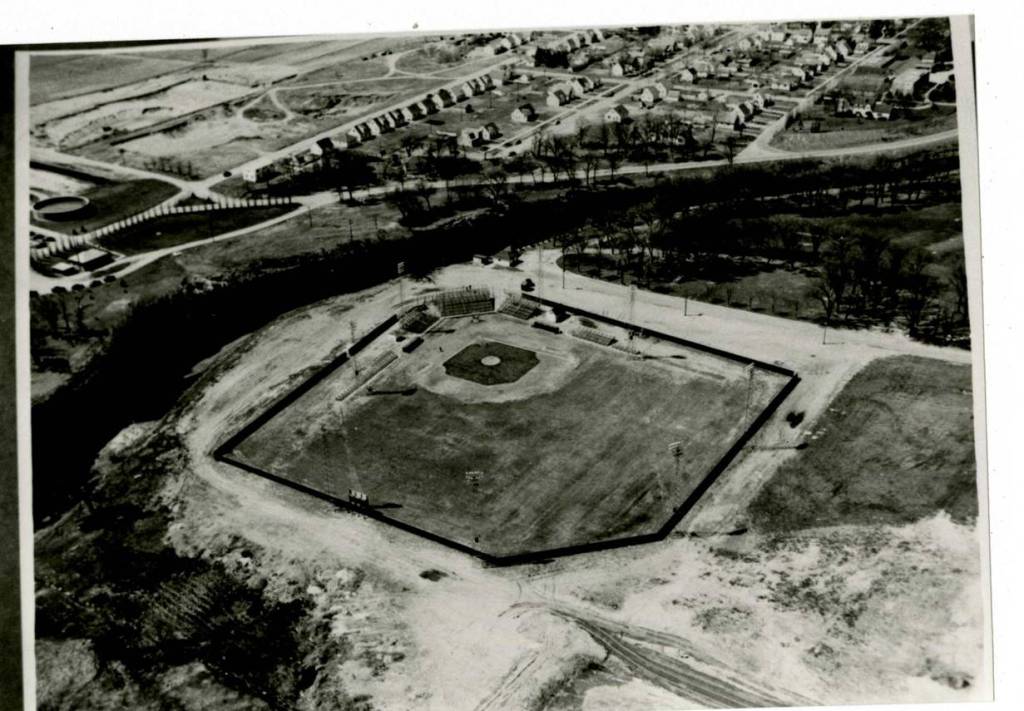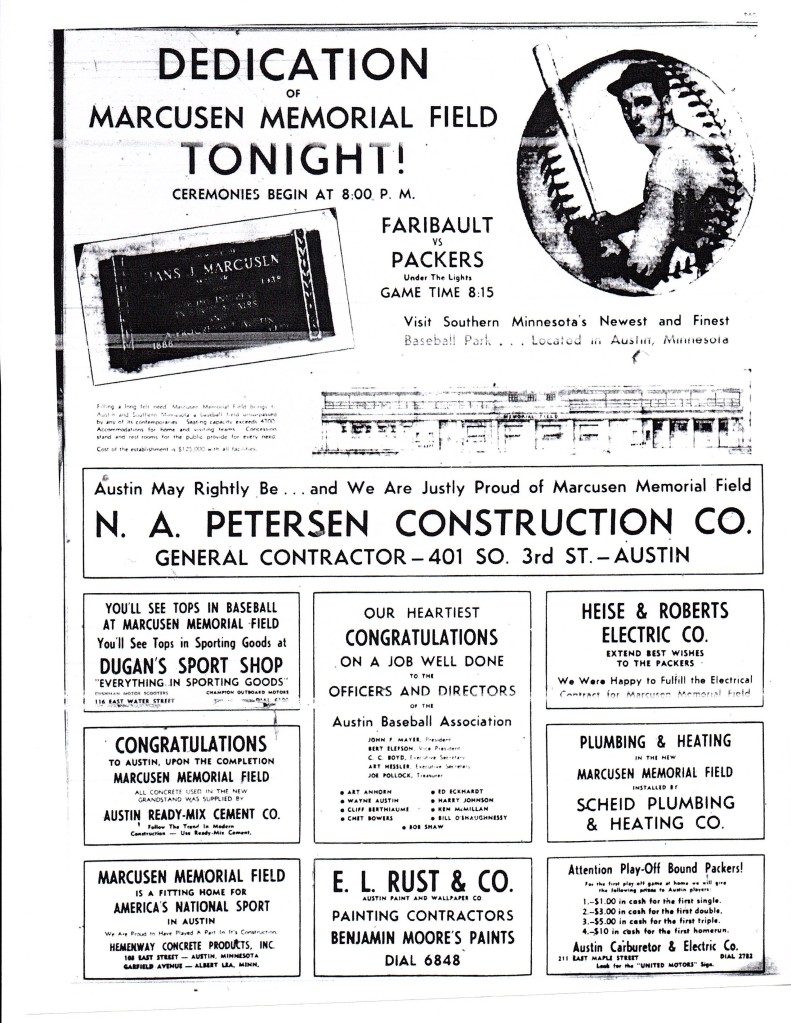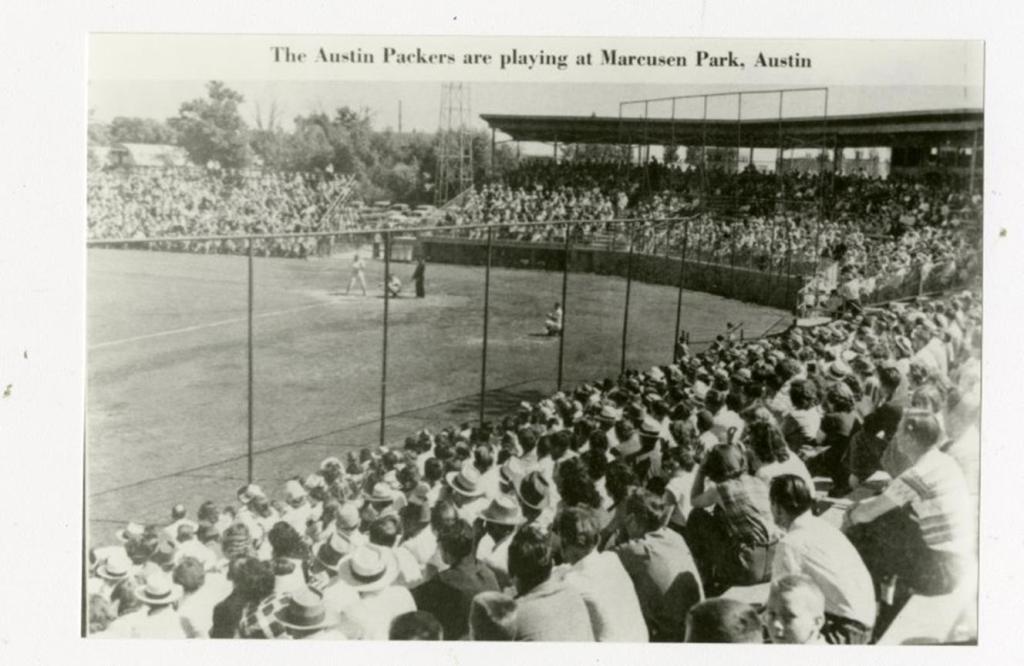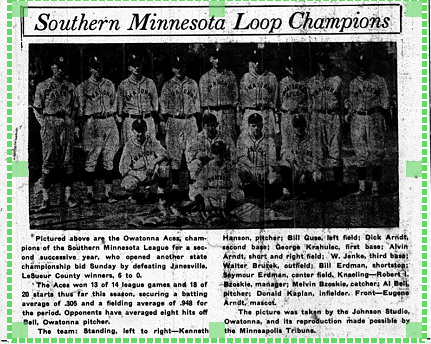Austin’s town ball teams have at times been truly dominant. The 1912 edition that featured future Hall of Famer Burleigh Grimes claimed a state championship prior to the state tournament even being created. When Burleigh returned to Austin with his Brooklyn teammates in 1921 the Austin team was playing at what was called the Hormel Ball Park near what later became the Terp Ballroom.
Austin featured a Southern Minny League team and a “Hormel Good Foods” team playing an independent schedule during the 1930’s. Those games were generally played at what is referred to as the “Marcusen lot.” When the Austin Baseball Association made the commitment to field one primary team in the Southern Minny, the team responded by winning the State Class A Championship behind the stellar pitching of Phil Golberg and hitting and fielding of tournament MVP Johnny Hulet.
Austin won the Southern Minny playoffs in 1939 playing its last games at the “Marcusen lot.” Despite the general airing of grievances about the conditions at the Marcusen lot, the next available option and the option used until Marcusen Memorial Field was built was the use of the Mower County fairgrounds. At least one drawing shows the baseball diamond in the infield area of the old track. The use of the fairgrounds effectively made the teams homeless as they physically could not play during the fair and usually didn’t play at home after the fair as the “field” was trampled and rutted.
Austin claimed an additional state championship in 1942 when Phil Golberg returned from playing in New Richland and shared pitching duties with Fred Ludke. Even though games continued to be played in the Southern Minny during the war, those games were played under travel restrictions with far fewer players let alone the best players available to play the games as many stars of the League entered military service. Austin’s baseball teams still lacked a permanent home.
With the end of the war, thoughts turned to recreational opportunities for the returning soldiers. With more players available, the Austin Baseball Association decided to field a team in the Southern Minny League and a team in the Cedar Valley League in 1946. Emil Scheid was given charge of the newly (re) formed Austin Merchants in the Cedar Valley League.
Emil had been involved in town ball in Waseca prior to moving to Austin. He knew how to build a team and his Austin Merchants were dominant in 1946. They won the Cedar Valley League and advanced to the Class A state tournament. But for an ankle injury to Bud Stanek, they might have claimed the championship before settling for runners-up status.
Emil was given charge of the Southern Minny entry in 1947 and set the stage for his later teams bringing in Earl Mosser and Ray Riley from out of town replacing Austin hometown players in the process. The transition to out of town players didn’t always sit well with the locals especially when Ray Riley replaced Bernard Stanek in center field. Even though Emil’s Packers didn’t always hit to the standards expected by the Austin fans the team record improved from a 6 and 8 in 1946 to 9 and 5 in 1947.
The problem was that the Austin teams were still largely homeless and it took revenue to pay top talent to play baseball. When paying players to play, it also made sense to play more games than just on Sunday. The problem being that of all of the teams in the league, Austin was the town without a ballpark and with no ballpark there were no lights. With no lights, there was no night baseball and with no night baseball. With no night baseball, playing opportunities on weekdays were also limited.
That stadium situation was finally rectified on June 8, 1948 when Scheid’s Austin Packers welcomed Sam House’s Spencer (IA) Cardinals to Marcusen Memorial Park. Lights were installed and tested on June 7th. With no time to build stands, bleacher seats accommodating up to 1,000 fans were installed.[1] 1,084 fans attended the game and hopefully were on hand to see Red Lindgren hit the first home run in the new park in the eighth inning.[2]
Even though the park was open for business, there was the matter of a formal dedication. The Local 9-CIO sponsored the ticket sales for the dedication game with the proceeds to be given to the city to help pay for the lighting system.[3] The game was initially scheduled as an exhibition game against Faribault to be held during the evening of June 27th.[4] The game was washed away by the weatherman.
The dedication was finally rescheduled to July 25th after another attempt was washed away. The event featured the municipal band and remarks by Mayor Merril Rolfson and Frank Schultz as union chief. The dedication included not only the field but the scoreboard and flag. The flag was donated by the American Legion and the scoreboard was provided by funds from the Earl Peterson estate.[5] Red Lindgren homered twice and Dick Seltz held Faribault in check as the Packers beat Faribault 9-3.[6]
Even though the park was open for business, the matter of fan accommodations remained an issue. This photo from the Mower County Historical Society files shows the park as built but without the grandstand or, quite frankly, much in the way of fan seating:

The lack of fan accommodations had no impact on on- the-field performance. Scheid’s Austin Packers fell one out short of claiming the Southern Minny postseason title in 1948. His 1949 Packers utterly destroyed the Southern Minny losing only 7 of 35 games played and swept through the rest of the field at the state tournament to claim the state class AA championship.
Marcusen Memoral Park would finally have a grandstand during the 1950 season. Construction of the grandstand was scheduled to be completed in time for the season opener but as with many things baseball related, the weatherman intervened.[7] The season opened on May 21st without the grandstand being available even though its construction greatly impacted parking. The Packers won 4-3 in extra innings with 1,505 fans in attendance.[8]
The Packers then went on the road for an extended period of time. By the time the Packers returned home to face Faribault, sections A,B and C and part of section D were available to the public.[9] Extra seating was needed because the Austin Queens team hired Negro League great and former Cleveland Indian Satchel Paige to pitch an exhibition game for them against Scheid’s Austin Packers on June 7th.[10]
Work continued on the grandstand and all seats became available to the public for the Packers June 25th game against Owatonna.[11] With the grandstand finished, the matter of dedicating it was scheduled for August 1st[12] along with an announcement that an additional 1000 bleacher seats were being added down the first and third base lines to raise the Park’s capacity to 5,000. A previous crowd of 4,423 greatly exceeded the capacity of the new grandstand.[13]
The full page advertisement in the Austin Daily Herald announced the dedication of Marcusen Memorial Field.

Part of the dedication advertisement read:
Filling a long felt need Marcusen Memoral Field brings to Austin and Southern Minnesota a baseball field unsurpassed by any of its contemporaries. Seating capacity exceeds 4700. Accommodations for home and visiting teams. Concession stand and rest rooms for the public provide for every need.[14]
The one thing needed was a roof over the field as rain delayed the dedication until August 3rd. Claude Moore, chairman of the park and recreation board served as master of ceremonies and introduced the speakers that included M.G. Rolfson, mayor, Waldo Swanson, president of the Southern Minny, and John Mayer, president of the Austin Baseball association. 4,057 fans turned out to see the Packers do their part on the field by defeating Waseca 8-7 with some late hitting heroics by Harry Elliot.[15]
Scheid’s Packer teams continued to dominate the Southern Minny in 1950, 1951 and 1953 advancing to the state Class AA finals in each of those years. With that success came crowds to Marcusen Memorial Park as this photo from the archives of the Mower County Historical Society amply illustrates:

Somewhat ironically, between 1949 and 1953 the Austin Packers made the finals of the State Class AA tournament every year except one: 1952. That was the year that Austin and Marcusen Memorial Field actually hosted the state tournament. It was also the only year during that time frame that Scheid’s Packers failed to even reach the tournament.
The House that Scheid Built was the scene of countless battles in the Southern Minny until the League’s demise in the 1960’s. Marcusen Park was, however, much more than just the home of the Austin Packers. Marcusen Park was and is the hub of baseball in Austin hosting a countless number of high school, American Legion, VFW games since its construction and continues today thanks almost entirely to the volunteers of the Marcusen Park Baseball Association that maintain the Park.
Thanks to those volunteers, Marcusen Memorial Park remains as a monument to a time before baseball on television and the internet. Even now, Austin’s Greyhounds remain atop of the Twin Rivers Conference after a hard fought victory over the Waseca Braves reminiscent of games between the Austin Packers and Braves in the old Southern Minny.
Marcusen will host more baseball this season as the Greyhounds host the Dodge County Diamondjacks on July 24th at 7:30. That final game of the Conference regular season may well be a battle for the top seed in the conference playoffs. Let’s hope Marcusen Park will be hosting playoff baseball once again.
[1] “Packers Open New Ball Park Against Spencer,” Austin (MN) Daily Herald, June 8, 1948.
[2] “Packers Gain 9-5 Decision Over Spencer,” Austin (MN) Daily Herald, June 9, 1948.
[3] Tom Koeck, “Success of Baseball Park Dedication Must be Credited to Local 9-CIO,” Austin (MN) Daily Herald, June 16, 1948.
[4] “Marcusen Park Dedication Sunday,” Austin (MN) Daily Herald, June 26, 1950.
[5] “Dedicate Diamond Sunday,” Austin (MN) Daily Herald, July 24, 1950.
[6] “Packers Win and Lose as They Roll Up Hits and Runs,” Austin (MN) Daily Herald, July 26, 1950.
[7] “Attendance Trophy Hopes at Marcusen Given Spur,” Austin (MN) Daily Herald, May 18, 1950.
[8] “Packers Win 4-3 in Extra Innings,” Austin (MN) Daily Herald, May 22, 1950, 8.
[9] “Faribault Lakers Play Here Sunday,” Austin (MN) Daily Herald, June 3, 1950, 5.
[10] “Austin Raps Paige for 3 Hits, 2 Runs,” Austin (MN) Daily Herald, June 8, 1950.
[11] “All Seats Available in New Grandstand,” Austin (MN) Daily Herald, June 24, 1950.
[12] “Dedication Scheduled at Marcusen Park,” Austin (MN) Daily Herald, August 1, 1950.
[13] “Additional 1000 Bleacher Seats Available Tonight,” Austin (MN) Daily Herald, August 1, 1950.
[14] Austin (MN) Daily Herald, August 1, 1950.
[15] “Elks Reward Scheid With Watch, Plaque,” Austin (MN) Daily Herald, August 4, 1950.

